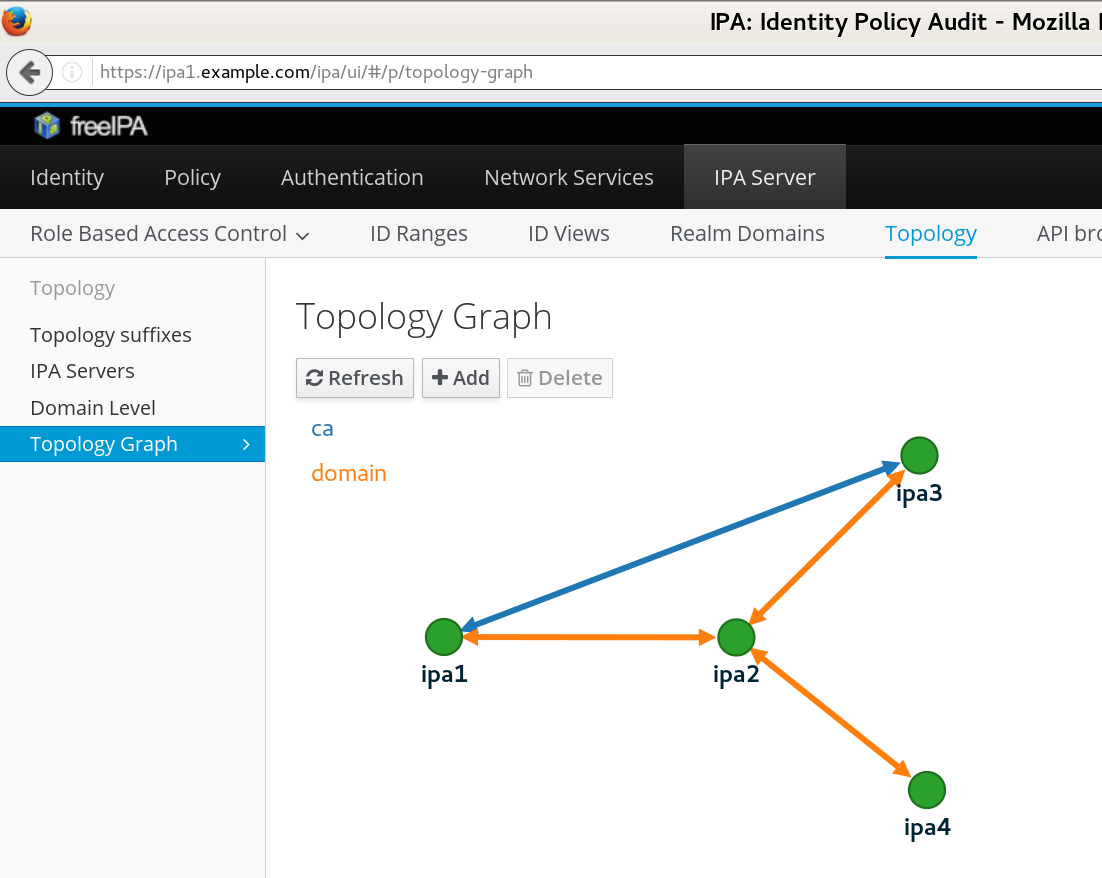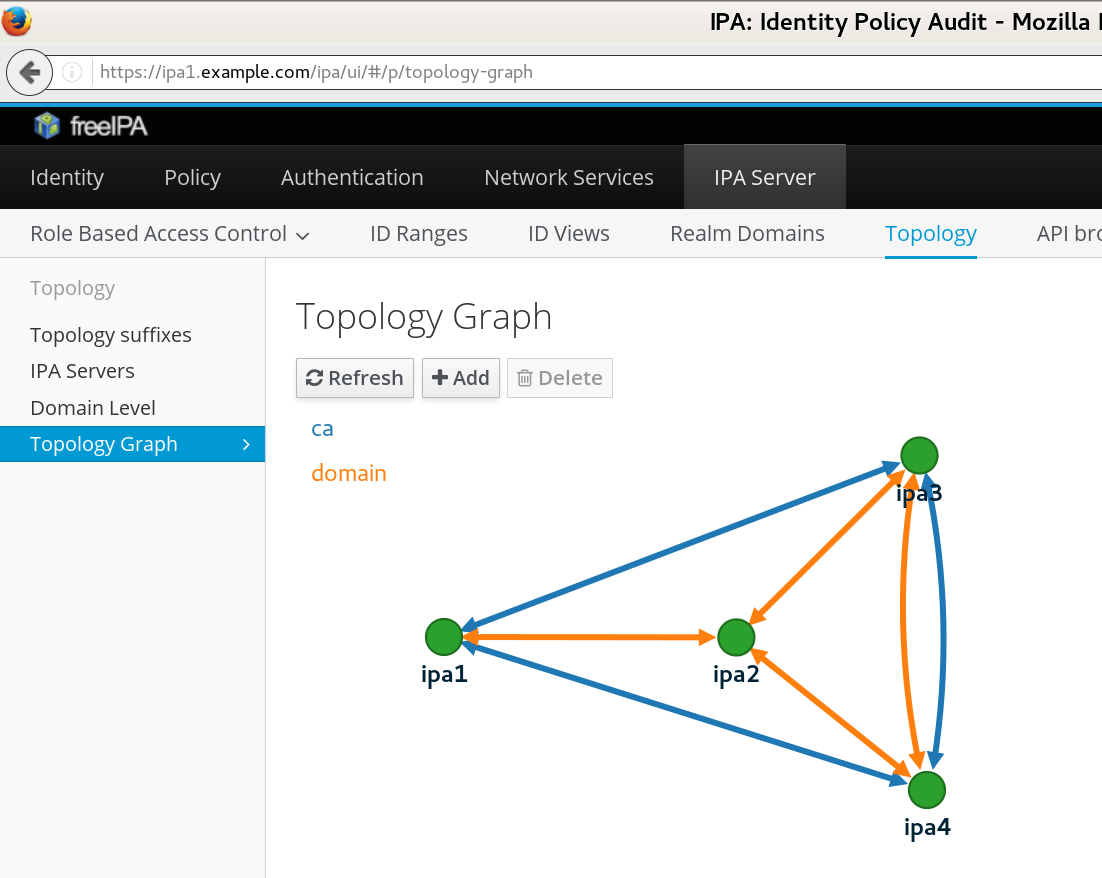High availability of infrastructure services
When planning and deploying pieces of infrastructure that affect performance or core functionality of large number of machines and services in computer network, it is essential to aim for high availability, as well as for efficient use of resources. It is often helpful when the software itself provides admins with clear and easy way to view and manage the more complex topologies of redundant services.
FreeIPA project is an integrated umbrella for multiple identity management related solutions like directory server, Kerberos Key Distribution center (KDC), certificate system, DNS server, and others. It can be used to manage identities from users, hosts, or services to DNS records, and access control policies for Pluggable authentication modules (PAM) or sudo. Operation of client machines and services can be tightly dependent on the availability of the IPA server, even if the client-side System Security Services Daemon (SSSD) is built around caching and can alleviate some of the impact of unavailable server. Still, when new user logs in for the first time or system is accessed for the first time, their identities (via Name Services Switch (NSS) or DNS) need to be looked up and resolved, and authenticity and authorization of the user for given service verified. Keeping IPA server available and accessible without network latencies is thus important.
FreeIPA has been built around multi-master replication provided by the 389 Directory Server. The complexity of creating the replicas and managing the topology in alignment with overall network needs used to be a hurdle that might have left some deployments in less than optimal state. With FreeIPA releases 4.3 and 4.4, new features were introduced that make much simpler the setup of replicas, management of the replication topologies, as well as control over which servers the client hosts will prefer. Let's look at those features and use cases.
Setting up FreeIPA replica
With older FreeIPA versions, creating new replica server involved
producing GPG-encrypted replica information file on the original
master server using the Directory Manager password. This file then
had to be copied manually to the replica machine and fed to the
ipa-replica-install command, which again required the
Directory Manager password. The need to run operations on the master
together with use of credentials which were not otherwise used in
standard day to day operation and management of IPA setup posed issues in
automated scenarios and provisionings of replicas.
The current versions introduce the notion of promotion of existing IPA-enrolled client to replica, initiated from the client side, typically with admin's credentials. No operation is needed on the master, and gone is the manual copying of the replica information file.
In fact, even the admin's credentials are not needed
on the replica machine. Special host group ipaservers
is used to control the ability of machines to promote themselves to
replicas, and the ipa-replica-install command can IPA-enroll
machine itself, for example using one-time password for the host.
If the admin (or some automated provisioning process) creates
host entry for new replica, lets the IPA server generate
random one-time password, and adds this new host to the
ipaservers host group, the one-time password can be used
on the replica machine to both IPA-enroll it and make it full replica.
One of the possible new workflows therefore can be:
client$kinit adminPassword for admin@EXAMPLE.COM:client$ipa host-add replica.example.com --random----------------------------- Added host "replica.example.com" ----------------------------- Host name: replica.example.com Random password: ImgXN_VxNC,B Password: True Keytab: False Managed by: replica.example.comclient$ipa hostgroup-add-member ipaservers --hosts=replica.example.comHost-group: ipaservers Description: IPA server hosts Member hosts: master.example.com, replica.example.com ------------------------- Number of members added 1 -------------------------
We see that the host entry and its host group membership was created from separate IPA-enrolled machine and no commands had to be invoked on the IPA master itself. On the replica machine, single command achieved both the IPA-enrollment, setup and configuration of the IPA server, as well as the replication agreement and configuration.replica#ipa-replica-install --password 'ImgXN_VxNC,B'Configuring client side components Client hostname: replica.example.com Realm: EXAMPLE.COM DNS Domain: example.com IPA Server: master.example.com BaseDN: dc=example,dc=com...Enrolled in IPA realm EXAMPLE.COM Created /etc/ipa/default.conf...Configuring directory server (dirsrv). Estimated time: 1 minute [1/43]: creating directory server user [2/43]: creating directory server instance...[28/43]: setting up initial replication Starting replication, please wait until this has completed. Update in progress, 6 seconds elapsed Update succeeded [29/43]: adding sasl mappings to the directory...[2/2]: configuring ipa-otpd to start on boot Done configuring ipa-otpd.
If the replica promotion starts with already IPA-enrolled machine,
we can check that the original configuration which pointed to the master
in /etc/ipa/defaults.conf
[global] server = master.example.com xmlrpc_uri = https://master.example.com/ipa/xmlgets updated to point to itself since the machine is now proper IPA server, after the promotion has finished:
xmlrpc_uri = https://replica.example.com/ipa/xml
Replication topology management
When the first replica is created, it is obvious that there is only one replication agreement between the original master and the new replica. But in larger deployments when there are dozens of IPA server in multiple datacenters on different continents, the way how replication of changes is propagated and how replication agreements are structured becomes important. The more is not always the better here — as general rule, the number of replication agreements on any given IPA server should not exceed four.
In older versions, it was of course possible to manage the replication
agreements but the command line tool ipa-replica-manage
(and ipa-csreplica-manage, for the certificate system
replication) had to be run on the IPA server, and the configuration
of replication agreement was local to the pair of
IPA servers in question.
With latest versions, all information about the replication topology, all the agreements (called segments), is stored in the directory server schema, and thus replicated to all servers in the domain. It is therefore possible to inspect the information with command line tools from IPA-enrolled clients or in WebUI. And the information is not just read-only view of the situation — when segment is created in the directory server, that information is replicated to all servers and when it reaches the target nodes of the new segment, establishment of new replication agreement is triggered. This is especially important when large domain of IPA servers needs to be managed centrally, without the ability to directly interact (with SSH) with the target IPA machines that might be in completely different geographical location. Having a way for replication to reach the remote IPA servers (potentially via chain of other IPA replicas) is enough to setup the replication agreement.
Let us assume situation of four IPA servers. The existing topology can be displayed graphically in Topology Graph in WebUI

topologysegment-find command:
ipa1$ipa topologysuffix-find--------------------------- 2 topology suffixes matched --------------------------- Suffix name: ca Managed LDAP suffix DN: o=ipaca Suffix name: domain Managed LDAP suffix DN: dc=example,dc=test ---------------------------- Number of entries returned 2 ----------------------------ipa1$ipa topologysegment-find domain------------------ 3 segments matched ------------------ Segment name: ipa1.example.com-to-ipa2.example.com Left node: ipa1.example.com Right node: ipa2.example.com Connectivity: both Segment name: ipa2.example.com-to-ipa3.example.com Left node: ipa2.example.com Right node: ipa3.example.com Connectivity: both Segment name: ipa2.example.com-to-ipa4.example.com Left node: ipa2.example.com Right node: ipa4.example.com Connectivity: both ---------------------------- Number of entries returned 3 ----------------------------ipa1$ipa topologysegment-find ca----------------- 1 segment matched ----------------- Segment name: ipa1.example.com-to-ipa3.example.com Left node: ipa1.example.com Right node: ipa3.example.com Connectivity: both ---------------------------- Number of entries returned 1 ----------------------------
Note that there are actually two replication topologies here — the domain for the IPA domain information and ca for the certificate system data. We see that only ipa1 and ipa3 run the certificate servers and have direct replication segment for that purpose, while the domain data is replicated via a “central” node ipa2.
If we'd like to add new segment (replication agreement) between servers ipa3 and ipa4, we can do so from any server, via WebUI or via command line tool. On the command line, we could use
If we refresh the Topology Graph on the WebUI, the new line between ipa3 and ipa4 will be shown there as well.ipa1$ipa topologysegment-add domain ipa3.example.com-to-ipa4.example.com \ --leftnode=ipa3.example.com --rightnode=ipa4.example.com------------------------------------------------------ Added segment "ipa3.example.com-to-ipa4.example.com" ------------------------------------------------------ Segment name: ipa3.example.com-to-ipa4.example.com Left node: ipa3.example.com Right node: ipa4.example.com Connectivity: both
It is worth noting that segment can be added only between nodes
that already act in given role. For instance, if we want to add
replication agreement between ipa3 and
ipa4 for the ca
suffix for the certificate system, we first have to enable
and configure the certificate system server on ipa4 with
ipa-ca-install. That will establish replication
agreement with the currently configured CA host (ipa1)
and only then we can
add the next segment. Running ipa topologysegment-find
or refreshing the page with the Topology Graph in WebUI would confirm
our new replication topology:

DNS-based locations
So far we have focused on replica setup and management on the server side. We can easily create replicas and tune replication topology. But how are the client machines able to use the replicated setup?
In typical scenarios, IPA-enrolled Linux machines will use
ipa-client-install to configure various components of
the operating system. That configuration can explicitly name
a particular IPA server, or it can rely on DNS SRV records to be
used to discover the correct service endpoint to use. In case of
SSSD, the ipa_server can force the SRV lookup
with _srv_ token, and it can be mixed with
hostname as well:
[domain/example.com] ipa_server = ipa1.example.com, _srv_will prioritize
ipa1.example.com and fallback to any
other server is can find via DNS. In older versions of FreeIPA,
this was the primary mechanism available for
“pinning” IPA clients to a particular close (in
terms of smallest latency) server.
The problem with this solution is its client-side nature. If additional
IPA server is installed in local datacenter, all clients might suddenly
need the new server listed in addition to the existing
ipa1.example.com:
[domain/example.com] ipa_server = ipa1.example.com, ipa2.example.com, _srv_The order of those hostnames would likely mean that the first server will be used by vast majority of clients while the second one will only be utilized when clients cannot reach the first one — hardly a fair load balancing. Other services and libraries might not even support mixing SRV DNS mechanism with explicit hostnames, making localized behaviour setup even harder.
To solve this problem, FreeIPA 4.4 introduces DNS-based locations. They allow grouping of IPA servers and assigning priorities to them, per individual locations.
The basic expectation is that in every network subset where clients are supposed to primarily use certain set of IPA servers, there is at least one IPA server (replica) running embedded DNS server, and that clients in that network subset are configured to use that DNS server. This part of the configuration is outside of IPA's handling — typically DHCP in individual network segments will be configured to provide local DNS server IP address first, and it will either be directly the IPA DNS server, or local DNS server which queries the IPA DNS server during recursive resolution.
IPA DNS server which is assigned to certain location (for example
emea) will autogenerate location-based CNAME records
for certain names:
_kerberos._udp.example.com,
_kerberos._tcp.example.com,
_ldap._tcp.example.com, ... they all will return
respective name under
emea._locations.example.com. Those SRV records will
in turn contain priorities for individual IPA servers based on
their membership in given location, and weights entered by
admin.
Let us see a simple emea location configuration:
When client machine resolves SRV record to autodiscover a service, it will be “redirected” via CNAME answer to the location-specific SRV record with location-specific priorities.$ipa location-show emeaLocation name: emea Servers: ipa1.uk.example.com, ipa2.uk.example.com Advertised by servers: ipa1.uk.example.com, ipa2.uk.example.com Servers details: Server name: ipa1.uk.example.com Service weight: 10 Service relative weight: 25.0% Enabled server roles: CA server, DNS server, NTP server Server name: ipa2.uk.example.com Service weight: 30 Service relative weight: 75.0% Enabled server roles: DNS server, NTP server
We see that depending on which IPA DNS server we query, we get priorities 0 for servers in the same location and 50 for servers outside of it.$dig +short @ipa1.uk.example.com. _kerberos._tcp.example.com SRV_kerberos._tcp.emea._locations.example.com. 0 10 88 ipa1.uk.example.com. 0 30 88 ipa2.uk.example.com. 50 10 88 ipa1.houston.example.com.$dig +short @ipa1.houston.example.com. _kerberos._tcp.example.com SRV_kerberos._tcp.us._locations.example.com. 50 10 88 ipa1.uk.example.com. 0 10 88 ipa1.houston.example.com. 50 30 88 ipa2.uk.example.com.
This way, SSSD only needs to use ipa_server = _srv_ and
other components on the IPA client machines do not need to configure
explicit hostnames of servers and services of IPA domain. Any
modification to the priorities takes place on the server side, and is
of course replicated to all IPA servers. This approach also caters nicely
to the needs of roaming users within the organization. Depending on
where they connect their laptop to the network, they will obtain local DNS
server IP address, and will thus resolve the SRV records via the closest
location.
Conclusion
With features focused on replicated setups and their management, latest FreeIPA releases make large-scale identity management deployments easier and more efficient. There are no longer any excuses for not having well set up FreeIPA redundancy.
References
FreeIPA project. https://www.freeipa.org/
Replica promotion. https://www.freeipa.org/page/V4/Replica_Promotion
Managing replication topology. https://www.freeipa.org/page/V4/Manage_replication_topology
DNS locations. https://www.freeipa.org/page/V4/DNS_Location_Mechanism
